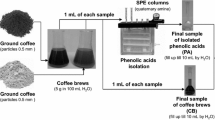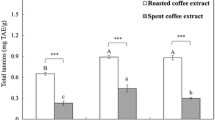Abstract
Our experiments investigated roles of phenolic compounds and melanoidins on antioxidant activity of Indonesia robusta and arabica coffee extracts. The 2,2,-diphenyl-1-picrylhydrazyl (DPPH) assay and a ferric reducing antioxidant power (FRAP) method were used to determine the antioxidant activity. An increase in the roasting degree (green, light, medium, and dark) reduced phenolic compounds and the antioxidant activity of coffee extracts, but enhanced melanoidin content. Principle component analysis (PCA) demonstrated that phenolic compounds showed stronger effects on antioxidant activity of coffee extracts in comparison with melanoidins. This finding was supported by the results of metabolomic fingerprint by partial least square (PLS), which describes the correlation of functional groups of coffee extracts on antioxidant activity. Based on the PLS analysis, hydroxyl groups (O–H) were observed to show a positive correlation, but carbonyl (C=O) and amine (N–H) groups were attributed to a negative correlation on antioxidant activity of coffee extracts.




Similar content being viewed by others
References
Pellegrini N, Serafini M, Colombi B, Del Rio D, Salvatore S, Bianchi M, Brighenti F. Total antioxidant capacity of plant foods, beverages and oils consumed in Italy assessed by three different in vitro assays. J. Nutr. 133: 2812–2819 (2003)
Ruiz G, Lake DS, Ames JM. In vitro antioxidant activity of coffee compounds and their metabolites. J. Agr. Food Chem. 55: 6962–6969 (2007)
Daglia M, Racchi M, Papetti A, Lanni C, Govoni S, Gazzani G. In vitro and ex vivo antihydroxil radical activity of green and roasted coffee. J. Agr. Food Chem. 52: 1700–1704 (2004)
Somporn C, Kamtuo A, Theerakulpisut P, Siriamornpun S. Effects of roasting degree on radical scavenging activity, phenolics and volatile compounds of Arabica coffee beans. Food Sci. Technol. 46: 2287–2296 (2011)
Bekedam EK, Schols HA, Van Boekel MA, Smit G. Incorporation of chlorogenic acids in coffee brew melanoidins. J. Agr. Food Chem. 56: 2055–2063 (2008)
Pastoriza S, Rufián JA. Contribution of melanoidins to the antioxidant capacity of the Spanish diet. Food Chem. 164: 438–445 (2014)
Dunn WB, Ellis DI. Metabolomics: current analytical platforms and methodologies. Trends Anal. Chem. 24: 285–294 (2005)
Shetty K, Curtis OF, Levin RE, Witkowsky R, Ang W. Prevention of vitrification associated with in vitro shoot clture of oregano (Origanum vulgare) by Pseudomonas spp. J. Plant Physiol. 147: 447–451 (1995)
Vignoli JA, Bassoli DG, Benassi MT. Antioxidant activity, polyphenols, caffeine and melanoidins in soluble coffee: The influence of processing conditions and raw material. Food Chem. 124: 863–868 (2011)
Craig PA, Franca AS, Oliveira LS. Discrimination between defective and non-defective roasted coffees by diffuse reflectance infrared Fourier transform spectroscopy. Food Sci. Technol. 47: 505–511 (2012)
Sacchetti G, di Mattia C, Pittia P, Mastrocola D. Effect of roasting degree, equivalent thermal effect and coffee type on the radical scavenging activity of coffee brews and their phenolic fraction. J. Food Eng. 90: 74–80 (2009)
Trugo LC, Macrae R. An investigation of coffee roasting using high performance liquid chromatography. Food Chem.19: 1–9 (1986)
Borrelli RC, Visconti A, Mennella C, Anese M, Fogliano V. Chemical characterization and antioxidant properties of coffee melanoidins. J. Agr. Food Chem. 50: 6527–6533 (2002)
Del Castillo MD, Gordon MH, Ames JM. Peroxyl radical-scavenging activity of coffee brews. Eur. Food Res. Technol. 221: 471–477 (2005)
Wang N, Fu Y, Lim LT. Feasibility study on chemometric discrimination of roasted arabica coffees by solvent extraction and fourier transform Infrared spectroscopy. J. Agr. Food Chem. 59: 3220–3226 (2011)
Liang N, Kitts DD. Antioxidant Property of Coffee Components: Assessment of Methods that Define Mechanisms of Action. Molecules. 19: 19180–19208. (2014)
Gonzalez-Rios O, Suarez-Quiroz ML, Renaud BR, Barel M, Guyot B, Guiraud JP, Schorr-Galindo S. Impact of ‘‘ecological’’ post-harvest processing on coffee aroma: II. roasted coffee. J. Food Compos. Anal. 20: 297–307 (2007)
Moreira AS, Nunes FM, Domingues MR, Coimbra MA. Coffee melanoidins: structures, mechanisms of formation and potential health impacts. Food Funct. 3: 903–915 (2012)
Author information
Authors and Affiliations
Corresponding author
Ethics declarations
Conflict of interest
The authors declare no conflict of interest.
Rights and permissions
About this article
Cite this article
Kurniawan, M.F., Andarwulan, N., Wulandari, N. et al. Metabolomic approach for understanding phenolic compounds and melanoidin roles on antioxidant activity of Indonesia robusta and arabica coffee extracts. Food Sci Biotechnol 26, 1475–1480 (2017). https://doi.org/10.1007/s10068-017-0228-6
Received:
Revised:
Accepted:
Published:
Issue Date:
DOI: https://doi.org/10.1007/s10068-017-0228-6




